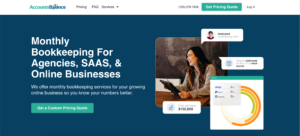
Interested in the SAAS business model? Thinking about starting a SAAS business?
We’ve got you covered!
My name is Connor Gillivan. I’m an Entrepreneur that’s started 8+ companies, scaled multiple to 6, 7, and 8 figures with an exit in 2019.
I’ve been using SAAS products for years and know the ins and outs of how they work as a business model.
In this article, we’ll break the SAAS business model down so that you can understand it as well.
Here’s what we’ll cover:
- What Is the SAAS Business Model?
- How Do SAAS Businesses Make Money?
- Pros of SAAS Businesses
- Cons of SAAS Businesses
- SAAS Business Example #1: Shopify
- SAAS Business Example #2: Slack
- SAAS Business Example #3: MailChimp
- 5 Tips for Running a SAAS Business
What Is the SAAS Business Model?
The SAAS business model is a software distribution model in which a third-party provider hosts applications and makes them available to customers over the internet.
SaaS companies typically charge customers on a subscription basis, either monthly or annually, for access to their software.
Unlike traditional software models, SaaS companies are responsible for the infrastructure, maintenance, and security of their applications, freeing up customers to focus on their own core business activities.
SaaS businesses have become increasingly popular in recent years due to their cost-effectiveness, scalability, and accessibility. By offering their services over the internet, SaaS companies can reach a global audience, reduce the need for physical infrastructure, and provide customers with flexible pricing and deployment options.
Successful SaaS businesses are typically highly focused on their target market, often serving a specific niche or industry. They invest heavily in product development and user experience to create highly usable and valuable applications.
To remain competitive, SaaS businesses must constantly innovate and adapt to changing customer needs and technological advancements.
How Do SAAS Businesses Make Money?
SaaS businesses make money through subscription-based pricing models.
They typically offer a variety of pricing tiers to customers, each with different features and levels of access to the software. These pricing tiers can range from basic to premium, with the premium options often including advanced features, additional support, and higher usage limits.
One of the benefits of the subscription-based model is that it provides a predictable revenue stream for SaaS companies.
By charging customers on a recurring basis, SaaS companies can better forecast revenue and plan for future growth.
Additionally, the subscription model helps build customer loyalty, as customers are more likely to continue using a service that they have invested in over time.
SaaS companies may also offer add-ons or integrations to their software, which can be sold as one-time purchases or as part of a recurring subscription.
Additionally, some SaaS businesses may generate revenue through advertising or sponsorships, although these models are less common.
It’s important for SaaS companies to carefully consider their pricing strategy, taking into account factors such as the value of their software to customers, the level of competition in their market, and their own costs of operation. A pricing strategy that is too high may deter potential customers, while a pricing strategy that is too low may limit revenue and profitability.
Pros of SAAS Businesses
There’s many reason to like the SAAS business model. Here’s 7 to consider:
- Scalability: SaaS businesses can scale rapidly due to their low overhead costs and the ability to provide services to a global audience. They can easily add or remove customers without significant investment in infrastructure or personnel.
- Predictable Revenue: SaaS businesses can count on a predictable revenue stream through recurring subscription-based pricing models. This allows them to forecast revenue and plan for future growth.
- Lower Costs: SaaS businesses do not require significant physical infrastructure or the same level of support staff as traditional software models. This can result in lower costs and higher profitability.
- Easy Deployment and Accessibility: SaaS businesses offer easy deployment and accessibility to their software. This allows customers to quickly access and use the software, without the need for extensive training or infrastructure investment.
- Customer Retention: The subscription-based pricing model can build customer loyalty and retention. Customers are more likely to continue using a service that they have invested in over time, rather than seeking out a competitor.
- Flexibility: SaaS businesses can offer a variety of pricing tiers and plans to meet the needs of different customers. This allows for flexibility in pricing and features, and can help attract a wider range of customers.
- Innovation: SaaS businesses are often highly focused on product development and innovation. They must constantly evolve to meet changing customer needs and technology advancements, resulting in better products and services over time.
Cons of SAAS Businesses

As with any business model, there’s also cons:
- Dependence on Internet Connectivity: SaaS businesses require reliable internet connectivity to operate. If there are disruptions in connectivity, customers may be unable to access the software, which can lead to frustration and lost revenue.
- Data Security Concerns: SaaS businesses must ensure that customer data is secure and protected from potential breaches. If a security breach occurs, it can lead to significant legal and reputational risks.
- Subscription Fatigue: Customers may experience subscription fatigue due to the sheer number of SaaS products available in the market. This can result in a higher churn rate and difficulty in retaining customers over the long-term.
- Limited Customization: SaaS products are often designed to be highly usable and accessible to a wide range of customers. This can lead to limited customization options, which may not meet the specific needs of some businesses or individuals.
- Limited Control: SaaS businesses must rely on their providers for infrastructure, maintenance, and security. This can lead to limited control over these areas and potential risks if the provider experiences issues.
- Price Increases: Customers may experience price increases over time, which can lead to dissatisfaction and a higher churn rate. SaaS businesses must carefully balance the need for revenue growth with the need to maintain customer loyalty.
- Integration Challenges: Integrating SaaS products with other software applications can be challenging, which can limit the ability to create seamless workflows and reduce productivity.
SAAS Business Example #1: Shopify
Shopify is a SaaS business that provides an e-commerce platform to businesses of all sizes. The company was founded in 2006 and has grown rapidly, currently serving over 1 million businesses in more than 175 countries. Shopify is a great example of a successful SaaS business, as it provides a wide range of software services to its customers via a subscription-based model.
Shopify offers a variety of software services to its customers, including an e-commerce website builder, payment processing, shipping and fulfillment, marketing and SEO tools, and customer engagement tools. These services are all delivered via the cloud, meaning that customers can access them from anywhere with an internet connection. This makes it easy for businesses to set up and run an online store without significant investment in physical infrastructure or personnel.
Shopify’s subscription-based model is a key characteristic of a SaaS business. The company offers several pricing tiers, ranging from basic to advanced, with each tier providing different levels of access to the software and features. Customers can choose the tier that best meets their needs and budget, and can easily upgrade or downgrade as their business grows and evolves.
Another important characteristic of a SaaS business is its focus on customer success. Shopify offers extensive customer support, including 24/7 phone, email, and chat support, as well as an extensive library of resources and tutorials to help customers get the most out of the platform. This focus on customer success helps to build customer loyalty and retention, which is key to the long-term success of a SaaS business.
SAAS Business Example #2: Slack

Slack is a popular SaaS business that provides a team collaboration platform to businesses of all sizes. The company was founded in 2013 and has grown rapidly, currently serving over 12 million daily active users across more than 150 countries. Slack is a great example of a successful SaaS business, as it provides a software service that is delivered via the cloud and uses a subscription-based model.
One of the key characteristics of a SaaS business is the delivery of software services via the cloud. Slack provides its team collaboration platform via a cloud-based model, meaning that users can access the platform from anywhere with an internet connection. This makes it easy for teams to collaborate and communicate with each other, regardless of their location or time zone.
Another key characteristic of a SaaS business is the use of a subscription-based model. Slack offers a variety of pricing tiers, ranging from a free plan to several paid plans with more advanced features. Customers can choose the tier that best meets their needs and budget, and can easily upgrade or downgrade as their team grows or their needs change.
Slack also demonstrates a strong focus on customer success. The company offers extensive customer support, including 24/7 phone, email, and chat support, as well as an extensive library of resources and tutorials to help users get the most out of the platform. This focus on customer success helps to build customer loyalty and retention, which is key to the long-term success of a SaaS business.
In addition to its strong SaaS business model, Slack also has a number of unique features that make it a popular choice for team collaboration. For example, the platform allows users to create channels for specific topics, which helps to keep conversations organized and focused. It also allows users to integrate with other software applications, such as Google Drive and Trello, to create a seamless workflow.
SAAS Business Example #3: MailChimp
Mailchimp is a SaaS business that provides email marketing services to small and medium-sized businesses. The company was founded in 2001 and has since grown to serve over 12 million users worldwide. As a SaaS business, Mailchimp uses a cloud-based model to deliver its software services, making it easy for users to access the platform from anywhere with an internet connection.
One of the key features of Mailchimp as a SaaS business is its focus on customer success. The company offers extensive customer support, including email and chat support, as well as an extensive library of resources and tutorials to help users get the most out of the platform. By focusing on customer success, Mailchimp has been able to build a loyal customer base, which is crucial to the long-term success of any SaaS business.
Another important aspect of Mailchimp’s SaaS business model is its use of a subscription-based pricing model. Mailchimp offers a range of pricing tiers, from a free plan to several paid plans with more advanced features. This allows customers to choose the plan that best meets their needs and budget, and makes it easy to upgrade or downgrade as their business grows or their needs change.
Mailchimp’s email marketing platform has a range of unique features that make it a popular choice for businesses looking to improve their email marketing efforts. These include the ability to create automated email campaigns, which saves time and improves efficiency, as well as analytics and reporting features that help businesses track the success of their email campaigns and make data-driven decisions.
5 Tips for Running a SAAS Business

Take these 5 tips into mind for starting and running a SAAS business:
- Focus on customer success: SaaS businesses are highly dependent on customer satisfaction and retention. Make sure to prioritize customer support and success, and regularly gather feedback from your customers to understand their needs and pain points.
- Embrace agile development: SaaS businesses require frequent updates and improvements to remain competitive. Embrace an agile development process that allows for rapid iteration and improvement based on customer feedback.
- Optimize pricing: Pricing can make or break a SaaS business. Experiment with different pricing models and tiers to find the optimal pricing structure that maximizes revenue while still providing value to customers.
- Leverage data and analytics: SaaS businesses generate a lot of data, which can be used to improve the product, pricing, and customer experience. Make sure to leverage data and analytics tools to gather insights and make data-driven decisions.
- Invest in marketing and growth: SaaS businesses often require significant investment in marketing and growth to acquire new customers. Develop a comprehensive marketing strategy that includes digital marketing, content marketing, and social media marketing to attract new users and increase revenue.
What Is AccountsBalance?

AccountsBalance is a monthly bookkeeping service specialized for agencies & SAAS companies.
We take monthly bookkeeping off your plate and deliver you your financial statements by the 15th or 20th of each month.
You’ll have your Profit and Loss Statement, Balance Sheet, and Cash Flow Statement ready for analysis each month so you and your business partners can make better business decisions.
Interested in learning more? Schedule a call with our CEO, Nathan Hirsch.
And here’s some free resources:
In Summary
The SAAS business model has become wildly popular in the last 20 years.
As the Internet has exploded in popularity worldwide, so have SAAS products.
At their core, SAAS businesses provide a tool that business owners and consumers can use to enhance their lives.
If you still have questions about SAAS companies, reach out to us at [email protected].
Cheers!









